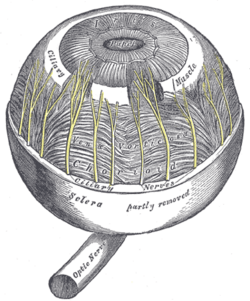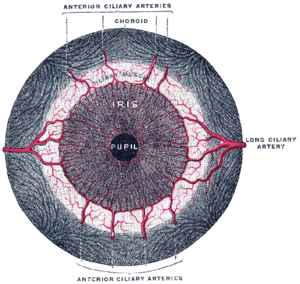Ciliary muscle facts for kids
Quick facts for kids Ciliary muscle |
|
|---|---|
 |
|
| The choroid and iris. (Ciliary muscle is labeled near top.) | |
| Latin | musculus ciliaris |
| Artery | long posterior ciliary arteries |
| Vein | Vorticose vein |
| Nerve | short ciliary From oculomotor nerve Through ciliary ganglion Sympathetic postganglionic fibers from sup. cervical ganglia. |
The ciliary muscle is a special ring-shaped smooth muscle found inside your eye. It's a super important part of your vision because it helps you see things clearly, whether they are far away or very close. This muscle works by changing the shape of the lens inside your eye, which is like the camera lens of your eye. It does not change the size of your pupil.
Contents
What is the Ciliary Muscle?
The ciliary muscle is located in the middle layer of your eye, called the uvea. Think of it as a small, circular muscle that sits right behind your iris (the colored part of your eye). It's connected to the lens of your eye by tiny fibers called zonular fibers.
How Does it Help You See?
The main job of the ciliary muscle is something called accommodation. This is the process where your eye changes its focus to see objects clearly at different distances.
Seeing Close-Up
When you look at something close, like a book or your phone, the ciliary muscle contracts (gets shorter). This makes the zonular fibers relax, which allows the lens to become thicker and more rounded. A thicker lens helps your eye focus light from nearby objects onto your retina (the back of your eye), so you can see them sharply.
Seeing Far Away
When you look at something far away, like a mountain or a cloud, the ciliary muscle relaxes (gets longer). This makes the zonular fibers pull tighter on the lens, causing it to become thinner and flatter. A flatter lens helps your eye focus light from distant objects onto your retina, so they look clear.
Where Does it Get Its Power?
Like all muscles, the ciliary muscle needs signals to work. These signals come from nerves. The main nerve that tells the ciliary muscle what to do is called the oculomotor nerve. It sends messages through a small relay station in your eye called the ciliary ganglion.
The ciliary muscle also gets blood supply from small arteries, like the long posterior ciliary arteries, and its blood is drained by veins called vorticose veins.
Images for kids
-
Ciliary ganglion with parasympathetic fibers of ciliary nerves.
See also
 In Spanish: Músculo ciliar para niños
In Spanish: Músculo ciliar para niños




